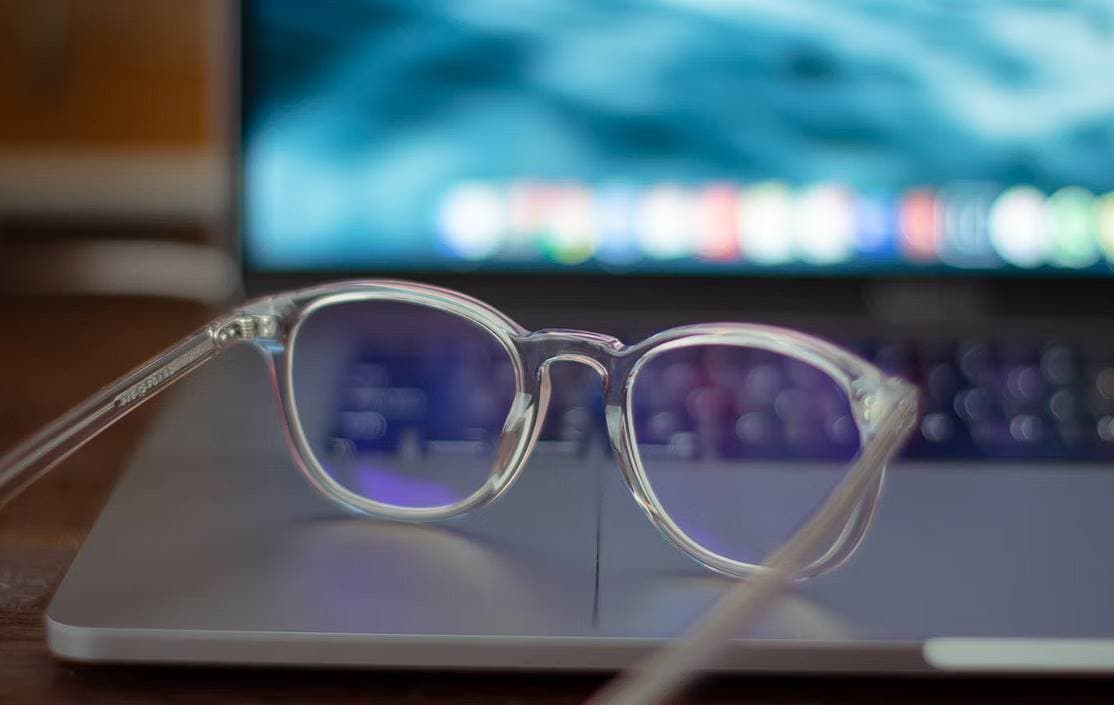Do you know why your eyes tire when you wear glasses for a long time? People who need glasses to see often worry about this. This piece investigates what causes this phenomenon and how it can affect your eyes. So, let's investigate the interesting link between eyeglasses and fatigue in the eyes.
Long-term use of corrective lenses can cause eye fatigue from the frequent refocusing required. Nearsightedness, farsightedness, and other refractive faults can all be corrected by the lenses of your glasses. However, when glasses are worn regularly, the eyes learn to rely on them, and the muscles used for focusing may atrophy. This can cause discomfort, tiredness, and even headaches owing to the tension on the eye muscles.
However, you may take measures to lessen the burden on your eyes and keep them in good working order. Read on for expert-recommended strategies for relieving the strain on your eyes that comes from always donning your specs. Find out how to rest your eyes, build stronger muscles, and forestall future problems. Let's look at the ophthalmology field and ensure your eyes stay fresh and intense even after extensive use of corrective lenses.
Taking good care of your eyes is essential to have a clear, pleasant vision for the rest of your life. Listen in to find out helpful advice from well-known eye doctors and how to make using eyeglasses less hassle. Join me on this eye-opening adventure!
The Causes Of Eye Strain And How To Prevent Them
Asthenopia is the medical term for what most people call "eye strain," which is the discomfort or exhaustion of the eyes. It happens when you stare at anything for too long, such as reading, using a computer, or focusing on something up close. There are several causes of eye strain.
- Eye Muscles Fatigue: Eye strain occurs when the muscles that focus the eyes become overworked and exhausted.
- Poor Lighting Conditions: When eyes work harder to adjust to their surroundings due to inadequate or excessive brightness, strain occurs.
- Blue Light Exposure: Blue light, emitted by computer screens, can cause headaches and alter sleep cycles, yet its use is on the rise.

The Impact Of Glasses On Eye Fatigue.
Glasses may help with your vision but may also cause discomfort in your eyes. Having an awareness of these consequences can aid in taking preventative measures:
Accuracy of Prescriptions
When you wear glasses that aren't the right prescription, your eyes must work harder to make up for the difference.
Improper Fit
Wearing glasses that don't fit properly can be irritating and tiring on the eyes. Making sure things fit right is essential for reducing these kinds of problems.
Lens Filters and Coatings
By reducing glare and filtering out potentially damaging light, unique coatings on glasses can alleviate eye strain.
Why Do We Wear Glasses In The First Place?
Refractive faults are typically corrected with glasses. Most people have refractive defects, making it difficult to see things properly and leading to double vision, squinting, migraines, eye strain, or glare. It's crucial to get frequent eye exams because refractive problems are only sometimes noticeable.
Some of the most common causes of refractive errors include an individual's eye shape and the age of their lenses. They alter your visual perception by interfering with the eye's natural light processing and preventing the retina from receiving adequate light. Some examples of refractive errors are:
- Myopia (nearsightedness): Far away objects look blurry.
- Presbyopia: Occurs in middle-aged adults and makes it difficult to see things up close.
- Astigmatism: Far and near objects look blurry.
- Hyperopia (farsightedness): Near and intermediate objects look blurry.
Possible Cause New Eyeglasses May Feel Uncomfortable
Have you just bought a new pair of glasses but are already experiencing headaches and other discomforts? Confidence-wise, you have company. This is a widespread problem with multiple potential causes. Getting to the bottom of these causes will allow you to take action and find the relief you need.
One probable reason for the discomfort could be an improper prescription. Strain and pain can result from wearing eyeglasses that aren't perfect for your eyes. The compatibility of the eyewear is yet another consideration. Misaligned eyewear can lead to painful pressure points. Finally, your eyes may need time to adjust to the new prescription after getting progressive or bifocal lenses.
Discovering why your new glasses don't feel quite right is crucial to fixing the problem. In our in-depth essay, we explore each potential explanation and include expert commentary from optometrists and other professionals in the field. Learn easy solutions to alleviate pain and improve the wearability of your eyewear. Don't let the hassle of breaking in your new glasses keep you from learning the truth.
Your Eyes Are Still Adjusting
Six muscles in your eye will need to adapt to your new glasses. Muscles in this area will be put through their paces more than usual while you adapt to your new eyewear. Because of this, you can get headaches and eye strain. This is especially common among people trying glasses for the first time. It's also possible if your doctor suddenly changes your prescription.
Is this your first time with bifocals, trifocals, or progressives? It could cause the annoyance you're experiencing with your glasses. These glasses are designed to address multiple vision problems by changing the lens power in at least one eye. You must look through the lenses at the appropriate location to get the proper vision correction from your glasses. Long-range vision and safe driving are best accomplished with the upper portion of the lenses. Close-up tasks, like reading, can be done with the lower portion of the lenses.
Glasses Nose Pads May Be Incorrect.
Do you find marks on your face or nose when you remove your spectacles? Taking your glasses off at regular intervals during the day will prevent the formation of these marks. This allows your skin to aerate better. Massage is one method for getting rid of the marks. You can also get some nose pads for your spectacles.
Your Eyeglasses Are Too Big or Too Small.
If your spectacles are properly adjusted, the bridge of your nose won't feel pinched. The frame of your glasses shouldn't press against your face, even if you're bending down or shaking your head. Your glasses probably don't fit you if they shift about as you do. You should visit an eye doctor if your glasses often hurt your nose.
The nose pads of metal frames provide support and distribute the wearer's weight more evenly than plastic frames. Nose pads should be adjusted to the suitable bridge size and crafted from the appropriate material to ensure a comfortable and secure fit. You can feel discomfort if you don't press the nose pads firmly against your face. Try a different material for the nose pad, or have your glasses adjusted to fit better to see if that helps.
Your nasal bridge could hurt because your glasses are too heavy. This implies that you could still feel pain even though your glasses are perfectly fitted. Enquire about your optometrist's lightweight frame and lens alternatives when you next need a new pair.
You Should Get a Better Frame for Your Glasses
If you're experiencing discomfort behind the ears while wearing glasses, they may be too small for your head. It could be because your glasses are too big or small for your face. Wearing glasses can generate pressure behind the ears, which can cause headaches due to decreased blood flow.
See whether getting your glasses checked by an optician is helpful if it doesn't, consider looking into finding another pair. Refrain from assuming that you'll look good with any pair of glasses. Fortunately, many options are available from various frame manufacturers and designs. If you see a reputable eye doctor for assistance, you won't have to worry about this.
Furthermore, you may encounter discomfort or even agony if you wear headphones while wearing eyeglasses. Thin-framed glasses or headphones with a larger air gap between the ear and the music may be more comfortable options. It's also important to consider the thickness of the ear cushions while shopping for headphones.
It would be best if you Got Some Better Sunglasses for That.
The eyes might become tired by staring at digital devices like computers, smartphones, and TVs for long periods. If you spend most of your day at work on a computer, invest in a pair of computer glasses to protect your eyes. These glasses protect your eyes from digital blue light and help reduce eye fatigue.
Glasses designed for use with computers typically have anti-reflective and high-contrast lenses. It has a special coating that prevents reflections from lighting and electronic devices. These eyewear are tinted to increase visibility in low light conditions. They are normally available in occupational progressive lenses, single vision, and bifocal and trifocal lenses.
Computer glasses aren't a need for everyone, but they're useful for people of all ages when using computers. If computer use causes you to endure frequent headaches or eye strain, consult your optometrist about these glasses. It is a good idea to tell your eye doctor about any activities that may be giving you eye discomfort. This way, they can advise you on the best pair of glasses for your requirements.

Can Glasses Make My Eyes Worse?
Our eyesight deteriorates with age. Our eyesight inevitably declines as we age, and we must rely on reading glasses or contact lenses to compensate. However, many people worry that their eyesight will deteriorate even further as they age if they have to wear glasses. This misconception originates from the fact that prescription glasses create a dependency on the eyes.
The argument hinges on your unique prescription, which is based on factors such as the cornea's front curvature and the eyeball's length. To cut a long story short, corrective lenses such as glasses or contacts do not alter the structure of the eye in any way. Wearing the glasses for long daily periods will keep your prescription the same. Remember that refractive errors will worsen regardless of whether or not you use corrective lenses.
You'll always want to keep your glasses on because doing without them will make the world appear fuzzier. After all, you wouldn't be able to see anything without your glasses. But does this mean that you'll need your glasses even more now that you're using them?
The Effects Of Wearing The Wrong Glasses
Is it safe to assume you can keep using your glasses despite knowing you're wearing the wrong prescription? You can, but doing so will cause eye strain, especially if both lenses are incorrectly sized.
Wrong prescription warning signals could include individuals experiencing fatigue may also exhibit other symptoms related to eye discomfort and strain. Excessive tear production, difficulty keeping the eyes open, and soreness in the eyes are commonly reported. Blurry vision, often accompanied by back, neck, and shoulder soreness resulting from poor posture, can also be experienced.
Itching or burning sensations, along with dryness in the eyes, may be present. Persistent headaches, double vision, and trouble concentrating are additional signs that may indicate eye fatigue.
Conclusion
Wearing glasses all the time might induce fatigue and headaches in some people because of the strain it puts on the eyes. While glasses are effective in correcting nearsightedness, farsightedness, and other refractive flaws, they can cause discomfort, fatigue, and headaches if worn for long periods of time. To protect your eyes from fatigue, it's important to take preemptive precautions like getting your prescriptions checked and your glasses fitted properly and investing in lenses with anti-glare and UV-blocking coatings.
Double vision, squinting, headaches, eye strain, and glare are among the side effects of wearing glasses to correct refractive errors. Refractive issues, which can arise from a combination of factors including eye shape and lens age, necessitate regular eye exams. Refractive errors include nearsightedness (myopia), farsightedness (hyperopia), intermediate blurriness (presbyopia), and spherical aberration (astigmatism).
Six muscles in the eye require time to adjust, so new eyeglasses may feel strange at first. This might lead to fatigue and headaches. To ensure long-range vision and safe driving, the upper section of the lenses should be used, while the lower portion is best suited for close-up work like reading.
If you have the wrong-sized nose pads, you can avoid marks on your face and nose by removing them at regular intervals throughout the day. Using a massager or nose pads can also speed up the healing process and reduce the appearance of scars. Assuring a snug and comfortable fit, properly adjusted glasses won't rub on the face. Change the material or get them reshaped if the nose pads are still too loose or too tight. Taking these measures will help you avoid unpleasant and potentially damaging eye strain for the rest of your life.
If your glasses are too large or too heavy for your face, you may experience discomfort and even headaches from wearing them. Getting a superior frame and lens from an optometrist will help you prevent these complications. You should probably obtain a new pair of glasses if you're always feeling pressure behind your ears from them. Think about getting thinner-framed glasses or headphones with a bigger air gap between the ear and the music if you wear both at the same time.
Protect your eyes from the glare of your computer, phone, or TV by purchasing a good pair of sunglasses. These glasses shield your eyes from the harmful effects of digital blue light and help you work for longer without becoming tired. Single vision, bifocal, and trifocal lenses, as well as occupational progressive lenses, are also available.
Long-term use of corrective eyewear does not change the shape of the eye, thus your prescription will remain unchanged even if you stop wearing your glasses. Even with glasses or contacts, refractive faults grow over time. If the lenses in your glasses are the wrong size, you may have discomfort in your eyes. Fatigue, eye pain, blurred vision, itching or burning sensations, dryness, chronic headaches, double vision, and inability to concentrate can all be warning signs of a misfilled prescription.
Content Summary
- Long-term use of glasses can cause eye fatigue and strain due to frequent refocusing.
- The muscles used for focusing may weaken and cause discomfort, tiredness, and headaches.
- Expert-recommended strategies can help relieve strain on the eyes.
- Proper care of your eyes is crucial for clear and pleasant vision.
- Eye strain can be caused by prolonged staring at objects or poor lighting conditions.
- Blue light from computer screens can lead to headaches and sleep disturbances.
- Glasses can provide vision correction but may also cause discomfort.
- Accurate prescriptions are essential to prevent eye strain.
- Proper fit of glasses is important to avoid irritation and tiredness.
- Lens filters and coatings can reduce glare and eye strain.
- Refractive faults require glasses for correction and can lead to various vision problems.
- Regular eye exams are crucial to detect refractive errors.
- New glasses may feel uncomfortable due to improper prescription or fit.
- Adjusting to new glasses may cause headaches and eye strain.
- Different types of glasses (bifocals, trifocals, progressives) can affect comfort.
- Glasses nose pads should be adjusted or massaged to prevent marks on the face.
- Glasses that are too big or small can cause discomfort and should be adjusted.
- Nose pads in metal frames provide better support and weight distribution.
- Heavy glasses can cause pain, and lightweight alternatives should be considered.
- Glasses that are too small can cause pressure behind the ears and headaches.
- Comfortable headphones and glasses combinations should be chosen.
- Computer glasses can protect the eyes from digital blue light and reduce eye fatigue.
- Glasses for computer use have special coatings and tinted lenses.
- Computer glasses are beneficial for people experiencing eye strain from computer use.
- Prescription glasses do not worsen eyesight or change the eye's structure.
- Wearing glasses will not make the eyes rely on them more.
- Wearing the wrong prescription glasses can cause eye strain and discomfort.
- Symptoms of wearing the wrong glasses include fatigue, soreness, and blurry vision.
- Itching, burning, dryness, headaches, and double vision can indicate eye fatigue.
- Taking breaks and resting the eyes can help alleviate eye strain.
- Adjusting the brightness and lighting conditions can reduce eye strain.
- Limiting exposure to blue light from digital screens can prevent headaches.
- Regular eye examinations are crucial for maintaining healthy eyes.
- Getting the correct prescription and fit for glasses is important for comfort.
- Properly adjusted nose pads can prevent discomfort and marks on the face.
- Nose pads in metal frames provide better weight distribution and comfort.
- Lightweight glasses frames can reduce discomfort, especially for long-term wear.
- Properly fitted glasses should not cause pressure or headaches behind the ears.
- Comfortable combinations of headphones and glasses should be considered.
- Computer glasses can protect the eyes from digital blue light and reduce eye fatigue.
- Special coatings and tinted lenses improve visibility in low light conditions.
- Computer glasses are beneficial for people experiencing frequent headaches or eye strain.
- Prescription glasses do not worsen eyesight or change the eye's structure.
- Wearing glasses allows clear vision and prevents blurry vision.
- Wearing the wrong prescription glasses can cause eye strain and discomfort.
- Symptoms of wearing the wrong glasses include fatigue, soreness, and blurry vision.
- Itching, burning, dryness, headaches, and double vision can indicate eye fatigue.
- Resting the eyes and taking breaks can help alleviate eye strain.
- Adjusting lighting conditions and screen brightness can reduce eye strain.
- Regular eye examinations and proper prescriptions are important for eye health.
Frequently Asked Questions
Yes, there are several preventive measures you can take to minimize eye strain while wearing glasses. First and foremost, ensure that you have an up-to-date and accurate prescription. Regular eye exams are crucial to monitor changes in your vision. Additionally, practicing the 20-20-20 rule can help. Every 20 minutes, look away from your screen and focus on an object 20 feet away for 20 seconds. Taking frequent breaks and adjusting your workstation ergonomics can also make a significant difference.
Eye strain while wearing glasses can occur due to various reasons. One factor is incorrect prescription or outdated glasses. If your prescription is inaccurate or outdated, it can cause discomfort and strain on your eyes. Additionally, wearing glasses that do not fit properly or are positioned incorrectly on your face can also lead to eye strain.
In addition to the preventive measures mentioned earlier, there are a few more things you can do to alleviate eye strain. Adjusting the lighting in your environment to reduce glare and using artificial tear eye drops to keep your eyes lubricated can provide relief. It's also important to maintain good overall eye health by following a balanced diet, staying hydrated, and getting enough sleep. If you experience persistent eye strain or discomfort, it's advisable to consult an eye care professional for a comprehensive evaluation.
It is recommended to take breaks from wearing glasses at regular intervals to avoid eye strain. Every 20 minutes, look away from close-up work and focus on a distant object for about 20 seconds. This exercise relaxes the eye muscles and helps reduce strain. Additionally, taking longer breaks of 10 to 15 minutes every few hours can provide further relief and allow your eyes to rest.
Yes, there are alternatives to wearing glasses for extended periods. Contact lenses can provide a convenient option for vision correction without the need for wearing glasses. Additionally, some individuals opt for laser eye surgery or other refractive procedures to permanently correct their vision, eliminating the need for glasses altogether. However, it is important to consult with an eye care professional to determine the most suitable option for your specific needs.





